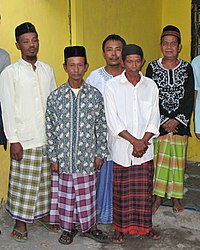Sarong

A sarong is a long piece of cloth, often cinched around the waist and worn as a skirt by both men and women in large parts of Southeast Asia excluding Vietnam, and on many Pacific islands. The fabric is often brightly colored or printed with intricate designs depicting animals or plants, geometric or checkered patterns, resembling the results of tie-dye. Sarongs are also used to decorate walls and to make other types of clothing, such as shawls, baby carriers, full dresses or upper body clothing.
The batik dyeing technique is associated with the production of sarongs.
Regional variations
In Europe and America, the fabric of the sarong is generally quite light, often being rayon. Western sarongs may have decorative borders on both ends. They also usually have ties, which are long, thin pieces of fabric used to help secure the sarong to the body and prevent it from falling due to the person's movement. They are frequently used in the West by women as a cover over their swimsuit, although they are normally called sarongs.
Sarongs are widespread in the southern state of Kerala in India, where they are called lungui. Unlike the ornately colored Asian sarongs, the Kerala variety is often plain white and worn for religious or ceremonial purposes. There are dresses based on mundu that can be worn by women, although they generally use the sari.
Fixing the garment
There are numerous fastening methods to secure a sarong to the body of its wearer. In some cases, these techniques differ considerably depending on the gender of the wearer. If the sarong has ties, they can be used to secure it in place. If there are no ties, a safety pin can be used, or one layer can be held tightly over another, tying the corners in a knot around the body, or even with a belt.
Similar garments
In Bangladesh men typically wear skirts called lungi. They are usually made of cotton, but they are also made of silk and other fabrics. They are often made in a long cylindrical shape, so that the lungi does not slide when tied. In West Bengal in India, a particular type of lungi, the dhuti, is common. In Burma, both men and women wear skirts called longyi.
On the coast of East Africa, the traditional clothing of Swahili men is a type of sarong called kikoy. They are made of cotton and have brightly colored horizontal bands.
Contenido relacionado
Tequila (disambiguation)
Wool
Top blanket